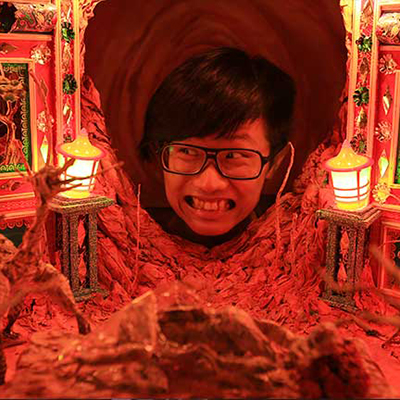“Craftsmanship” is the theme of this cycle’s Asia Seed project. Therefore, one of the key programmes of this Taiwan trip is to learn about an art festival in 2017, “Kau-Puê, Mutual Companionship in Near Future: Folk Art Parade ✕ Design Exhibition”. Thus, we met a number of participating artists, including Zhang Xu-zhan, Hsu Chia-Wei, Li Jun-yang, and Chen Po-i. Among them, Chen Po-i patiently explained to us the insider details of the exhibition. The Taiwanese (hokkien) term “Kau-Puê”, meaning “to build friendships” and “to accompany”, sounds very unfamiliar to us. Traditionally, it refers to the alliance in the worshipping activities of temples, where people build friendships and invite sponsorships. Borrowing the meaning, this large-scale exhibition of last year attempted to open up some channels to allow the “cross-infection” between contemporary art and folk art. It later triggered a new wave of discussions about folk/temple crafts in Taiwan’s art circle.
Our first stop in Taipei was to visit the traditional paper sculpture craft shop “
Hsin Hsin Paper Sculpture Store” run by
Zhang Xu-zhan’s family for generations. Participants were fascinated by the main ghost and god characters in Taiwanese folk beliefs. Father Zhang has been making paper sculptures for decades so he knows these myths and legends through and through. He told us in detail the stories about Taishang Laojun, Xuantian Emperor, Zhang Tianshi and Guan Gong, among others. He also shared with us the competition brought by mass-printed paper products. Later, we arrived at Tainan, a relatively old city with more old shops. We saw several kinds of traditional folk crafts. We visited traditional pastry chefs and Taiwanese three-dimensional embroidery “Tainan Kuang-Thai embroidery shop”. We also witnesses how father and son Chen Yu-feng and Chen Shou-yi integrate Western realism into temple paintings, as well as how Chin Men Theater continues to use traditional hand-painted movie billboards.
In Taichung, we visited artist Li Jiun-yang, who happened to have worked as a painter for movie billboards. He is the living example of the seamless convergence of traditional craftsmanship and contemporary art practice. Li’s studio-cum-home is full of all kinds of furniture, toys, artworks and musical instruments, among a portrait of Zunbao and Zixia from
Journey to the West that reveals his original profession as a movie billboard painter. The outdoor area stores a large pile of wood for creation. His range of interests is broad. Though he first started as a movie billboard painter, he later taught himself wood carving, ink painting and calligraphy. He knows how to make hand puppets too. The musical instruments he can play include the violin, cello, guqin and erhu. His painting style defies definition. Classic characters, mythical animals, his friends and Ultraman all appear in the same painting. Seemingly nonsensical, it is in fact a combination of his all-round skills and creativity accumulated over the years. It is free-flowing and unconstrained.
During our chats, Li Jiun-yang said not going to work is better for life. If people don’t work, there won’t be a lot of worries or hinderance and only then can er remove the constraints imposed by society and enable ourselves to do what we originally wanted to do. This also echoes Wong Tin-yan’s sharing at a dinner about choosing academic subjects. He doesn’t think the choice must be career-oriented. Apart from studying well and finding a good job, there are still many more choices out there. Staying in Taiwan for just ten days, we hurriedly went through so many artworks, spaces, institutions and people. I discovered the most precious part of art may be: our constant scepticism about the existing frames and boundaries and our unwillingness to be not confined by habits; to practise opening our eyes and be perspective (as demonstrated by Teacher Kurt Chan Yuk-keung’s curiosity and enthusiasm for everything around him in the trip); and to open up more imagination and possibilities so that we get to know more ways to face the world. If we can grasp what art has taught, even if it is just one step at a time, it will probably open up the path towards freedom one day.





